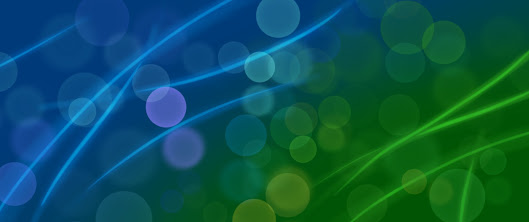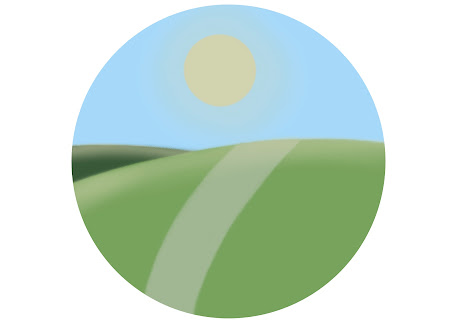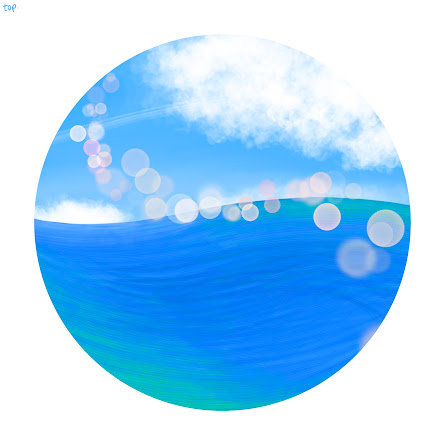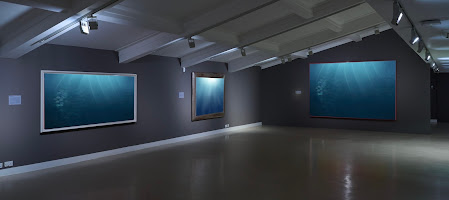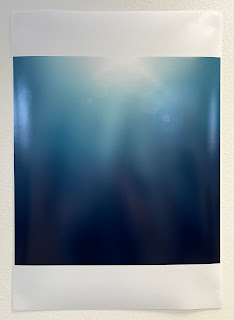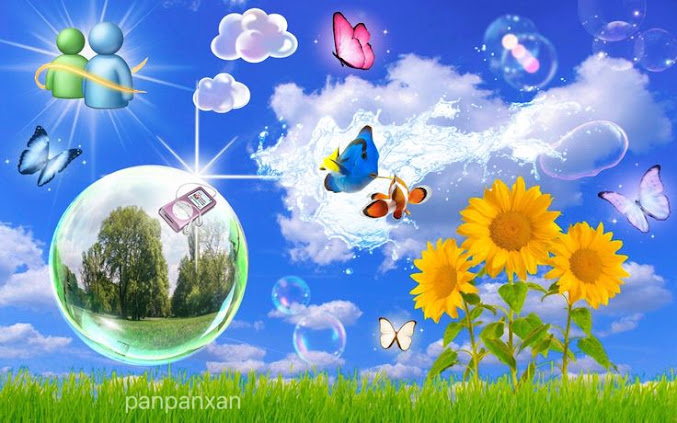Ella's Fine Art Foundation Degree
Wednesday, 21 May 2025
Module pieces - Frutiger Metro
Thursday, 13 February 2025
Module Pieces - Future of the past, Frutiger Aero (2024)
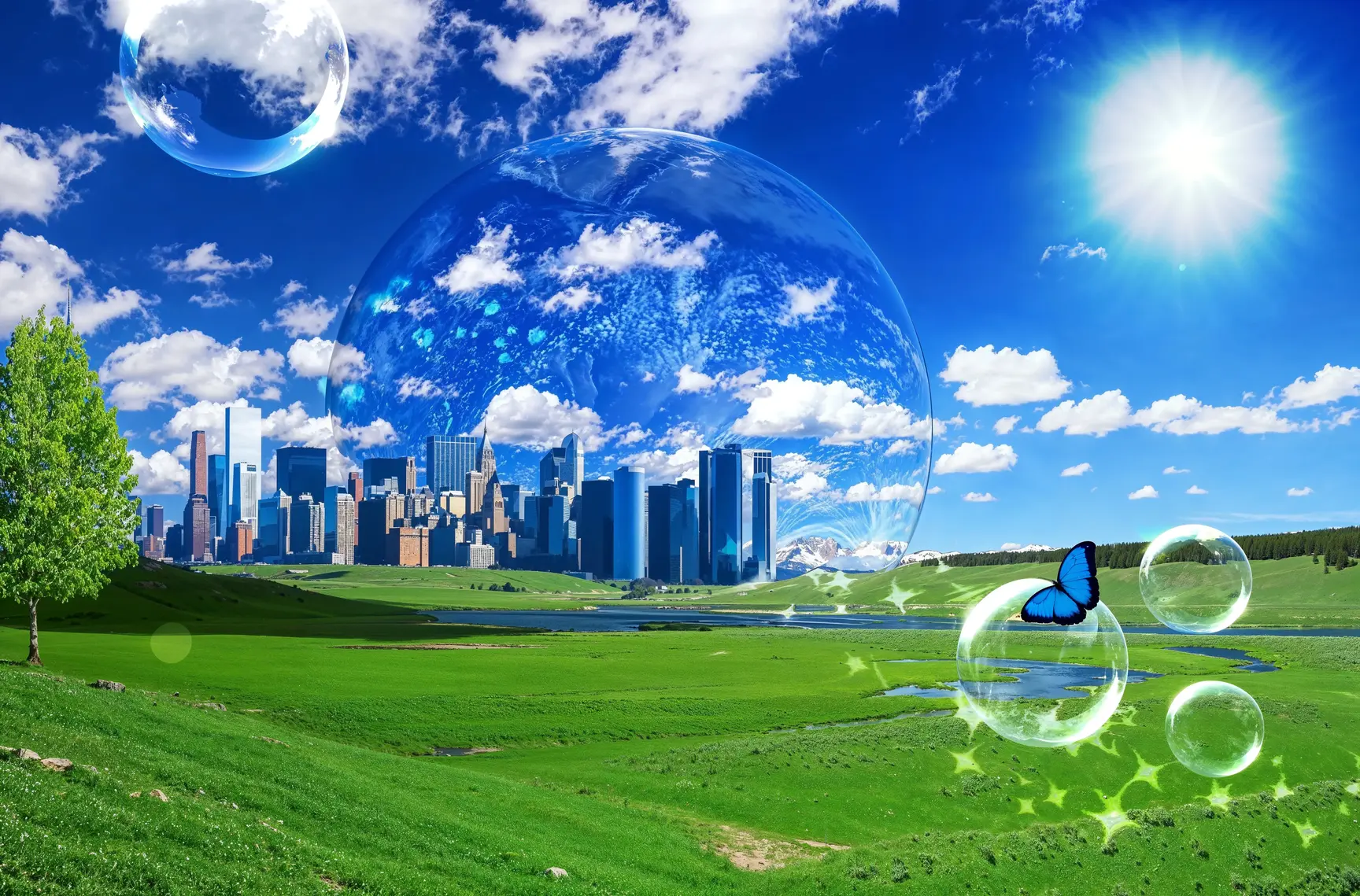
Introduction
Anemoia refers to nostalgia for an era one has never personally encountered; it encapsulates the longing for experiences or objects that are currently absent, such as Frutiger Aero. Through my artistic endeavours, I aim to express my affection for this sentiment and convey to viewers the essence of my emotional experiences. For me, the sensation of anemoia is inherently soothing, often evoked by revisiting locations from my childhood, such as the vividly recalled children's wing of a hospital adorned with fish murals on the walls and suspended from the ceiling while I awaited a check-up. These comforting memories encompass the details mentioned above and reflections on toys, games, and shows from my youth, all of which evoke pleasant recollections of simpler times.
This fascination with the aesthetic emerged from my desire to evoke similar feelings in others. My interpretations of this overlooked aesthetic may resonate with viewers who have encountered it in the past, even if only fleetingly, such as in a store or through digital media. I intend to delve into this aesthetic by recreating my interpretations using imagery from my daily surroundings. Additionally, I will emphasise the absence of human presence, thereby imparting a pristine quality to the scenes, as human activity often disrupts the natural state of environments, rendering them less appealing. Consequently, my artworks will strive to embody a sense of purity and untouched beauty.
Artist Research
A huge inspiration for this art style is Christian Riese Lassen; he is best known for being able to paint a vibrant, idealised vision of the natural world and its oceans; he was inspired by moving to the Hawaiian island of Maui as a child. The precision of his work showcases his ability to schedule ahead and his extreme organisational skills. Being an artist is the only career he has ever had. He was born to be an artist, and his paintings are in museums and exclusive private collections worldwide.
'It is called "marine art" and depicts the nature of the South Sea in a glittering style with the central motifs of Hawaii's undersea landscapes and marine life, such as dolphins.
The work gained popularity as inexpensive prints, lithographs, and jigsaw puzzles. Because the painting business method was extensively involved in improving its popularity in Japan, it was ignored by the art world's mainstream, just like Hiro Yamagata, due to his antipathy to its sales strategy.' – Wikipedia, Japan.
Three other artists that inspire are music artists, one of them being Infinity Frequencies on Spotify, more specifically their album Computer Afterlife (2014), as the cover art contains an old box computer in the middle of a blue, shiny background that is semi-low quality, thus fitting the early internet aesthetic. The music album contains multiple instrumental tracks that include a mellow and simple melody that is sometimes lightly muffled to make it seem old; all the while, some white noise is playing in the background, as this brings out reverbs and adds clarity.
The other artist on Spotify who has inspired me is Xploshi, with their album Rafflesia Online (2023). The album's cover is a glassy flower on a blue background with some light shining down, making it look glassy and shiny. The music consists of simple beats with a catchy melody that feels like it belongs in a shopping centre from the early 2000s and the internet in the same period; it's almost dream-like.
Another musical artist inspired me is Frutiger Aero: Final Destination (2024) by Koday Jackson. The background of the album cover consists of a small mix of light, a green and white blur. In contrast, the middle ground shows shiny cartoon-looking leaves with water droplets reflecting off light, and the foreground contains the globe in green with glossy features on its surface and more light reflecting off it, all while a green cartoon butterfly sits on its top. All the songs include simple beats and melodies, along with sounds you don't often hear in modern music, which helps make the music sound more retro and contain little base. Depending on the song's tempo, it seems dream-like, almost as if you're transported to the past, where there was nothing to worry about.
These songs make me feel nostalgic for times I have never experienced, and they also fit in with the theme I chose for my project.
Research on the topic
Frutiger Aero is a design aesthetic popular from the mid-2000s to the early 2010s. It was presented with a fresh, refined, calm style that succeeded the Y2K aesthetic. "Frutiger Aero" comes from Adrian Frutiger, a Swiss typeface designer who created many humanist typefaces in older computing interfaces and Windows Aero. The typefaces feature a glassy look for reflective control buttons and window borders.
Frutiger Aero was prevalent in user interfaces, internet aesthetics, tech, marketing, and logos to make the viewers notice the target more. Some design elements of Frutiger Aero include Glossy, shiny textures, a tertiary colour palette, bubbles, sparkling bokeh, grass, flowers, and nature (like butterflies and sealife).
Images used for inspiration
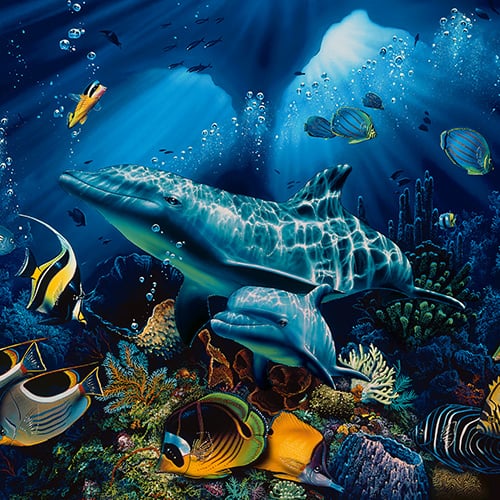

(Windows Vista, by Microsoft)
My experimentations
Latest to oldest, inspired by the various aspects of the aesthetic, including underwater and technology,
Final pieces
As these images were printed, I chose the size of A2 so that there is a border around the physical, enlarged image so it doesn't get damaged while presented. Seeing as the room that these images have been presented in shows a lot of natural light, and I found out that the reflections on the smooth paper make it appear glossy, better than I could have imagines it.
Wednesday, 13 November 2024
lake side 240924
We visited Lakeside Gallery to see Paula Rego and Grayson Perry's exhibitions, where each artist was given a room to set up their works. Both artists used different yet similar mediums, such as lithographs, printmaking, and carvings. With a variety of sizes both artists used, all sorts of details can be seen in all of their works, from small words only visible up close to quick and simple shapes that still show art pieces.
Rego was born and raised in Portugal during the Salazar dictatorship to Anglophile parents. These parents instilled in Rego a love for books and stories of all kinds and encouraged her to read and speak English. Rego was a voracious reader, and her early years were surrounded by great literature books whose vivid and graphic ideas made an indelible impression on her imagination.
Paula Rego: Visions of English Literature aims to spark new ways of seeing the world through these seemingly familiar, age-old stories.
In 1989, Rego made a book of Nursery Rhymes for her first granddaughter, Carmen, who was two years old. Her delight in turning the songs into pictures spurred her to make the long series of etchings.
She used these well-known figures from the nursery rhymes with her own twist to tell stories that combine fantasy and imagination, innocence and cruelty, to explore the complexities of life and the experience of women in particular, in all its strangeness and mystery. In her art, these stories can be told with just one glance.
(Baa, Baa Black Sheep, 1989, Etching and aquatint)
(Old Mother Goose, 1989, Hand coloured etching and aquatint)
Monday, 10 June 2024
Module pieces - bygone eras of the internet: Frutiger Aero (2023)
Introduction
Anemoia is nostalgia for a time you have never experienced; it also means having feelings for something that we don't have now but would like to have, such as Frutiger Aero. So, I am showing my love for this feeling through my work, trying to show viewers what I see when I feel such emotions. But to me, the state of anemoia is comforting, as it was triggered by revisiting places I visited when I was a young child, such as vividly remembering the children's wing of a hospital waiting for a check-up with all the fish on the walls and hanging from the ceiling. My comfort zones contain the details mentioned above, as well as thinking back at things I had used, played with or watched as a young child, as it brings back good memories of times that make me remember doing so.
This is how I became interested in this aesthetic. My versions of this forgotten aesthetic can bring back some memories to viewers who remember experiencing it in the past, even if they see it in passing, like inside a shop or on some software. I will explore this aesthetic by recreating my own versions using images of places I would see daily. I will also show the absence of people, thus giving them an immaculate look, as humans extract natural resources, making areas look unclean and unkempt. So, my pieces of art should look pure and untouched.
Artist Research
Frutiger Aero is named after Adrian Frutiger (who created the Frutiger fonts commonly used alongside Frutiger Aero) and Windows Aero (the UI theme of Windows Vista/7), which spread outward and influenced many other companies' design choices during the era. However, Sofi Lee coined the term Frutiger Aero in 2017 as a combination of Aero and the Frutiger typeface, which was popular with corporate materials of the time.
(an example of Frutiger Aero, Pinterest)
Research on the topic
Web 1.0, 2.0, and 3.0 are classic terms used to describe the evolution of the World Wide Web. Each iteration has brought new capabilities and changes to how we interact with the web.
1.0 emerged in the 1990s and was primarily used for information sharing and retrieval. Websites were static and mainly consisted of text and images. Users could only view and read the information but not interact with it. But everything changed after the second wave of internet evolution.
Web 2.0, which emerged in the early 2000s, introduced interactivity and user-generated content. With its changes, websites became more dynamic and allowed user participation through blogs, forums, and social networking features.
But soon, Web 3.0 made headlines as the "Semantic Web". It is said to be the next evolution of the World Wide Web. The concept behind Web 3.0 is to make the web more intelligent by using technology such as artificial intelligence, machine learning, and natural language processing. This would allow computers to understand and interpret web content in a more human-like way, making it easier for people to find the information they need. However, Web 3.0 is still under development, but some early examples include virtual reality, augmented reality, and voice-enabled search.
Artist Research
"James Casebere, born in 1953, is an artist with a similar style to this aesthetic. He grew up outside of Detroit and studied with Siah Armajani as an undergraduate at the Minneapolis College of Art and Design and John Baldessari as a graduate student at Cal Arts.
For over 40 years, Casebere has built and photographed architecturally based models which explore the relationship between sculpture, photography, architecture, and film. Starting with Sonsbeek '86, in Arnhem, Holland, through 1992, Casebere made large-scale sculptural installations.
His work is in the collections of and has been shown at major museums around the world, including the Museum of Modern Art, the Solomon R. Guggenheim Museum, and the Whitney Museum (New York); the Tate Gallery (London); the Los Angeles County Museum of Art (Los Angeles); and many others. He has had solo shows at the Musée d'art contemporain de Montréal (Canada); Centro Galego de Arte Contemporánea (Spain); Museum of Modern Art Oxford (UK); the Cleveland Museum of Contemporary Art (Ohio); the Indianapolis Museum of Fine Arts (Indiana); and other museums.
In 2016, his work was the subject of a major retrospective at the Haus der Kunst in Munich, Germany and has been included in exhibitions highlighting the work of what is now widely regarded as the Pictures Generation, the title of a 2009 exhibition at the Metropolitan Museum of Art in New York. Casebere receives three fellowships from the National Endowment for the Arts, three from the New York Foundation for the Arts and one from the Guggenheim Foundation. In April 2019, he was awarded the Abigail Cohen Rome Prize through the American Academy in Rome."
The image below is by Casebere, called 'Yellow House on Water', made in 2018. It shows a simple yellow house with no windows or doors, a very high doorframe, and a railless staircase to one of the rooms. This building is in front of a group of mountains that are silhouetted due to the dark, overcast clouds, yet its reflection is seen in the water in front of it, distorted by the water's surface ripples.
This has inspired me to create my own by taking a picture of some exterior or interior and editing or redrawing them to make them look white and clean so that I can add some frutiger aero aspects into it, such as glassy looking bubbles, significant things in a smaller space, like a giant butterfly in an average room. I have always been intrigued by retro aesthetics such as Frutiger Aero because this style reignites memories and stories of a particular time, making it unique. But these aesthetics give me a sense of anemoia.
Images that I took for some inspiration
Monday, 13 May 2024
Types Of Galleries, legal implications of being an artist (2024) and workshops with skill sharing
Art Dealers/ Gallerists
These represent artists and exhibit them in either group or solo shows. These higher-end venues are incredibly influential; you can choose who they represent. They have galleries in major commercial centres like London, Paris, New York and Berlin. They represent very established artists. They also participate in significant Art Fairs like Freeze or the Armoury Show. They sell art to top collectors and major public institutions like The Tate. They often take up to 50% commission. They only show artists who have major status. The good news is they show lots of great art for free.
Marina Abramovic. Ai Weiwei. James Casebere. Tony Cragg. Angela de la Cruz. Richard Deacon.
- Gagosian- Barbara Gladstone
Miroslaw Balka. Matthew Barney. Keith Haring. Thomas Hirschhorn.
- White Cube
Commercial Galleries
These sell work on behalf of artists and organise exhibitions, both solo and themed. Typically, artists meet all costs, including making, framing, and transporting, and they take a percentage of sales.
- Transition Gallery - London
This is a commercial stepping stone for top dealers. It shows established artists on the way up, and more established galleries monitor them.
- Tarpey Gallery - Castle Donington
Shows group and solo established artists. Less transitional due to regional location and place in the hierar
- Cupola Gallery - Sheffield
Deals with fairly established artists. Closer to a shop situation but also curates thematic shows
Hire spaces
These are bookable spaces run by artist's studio groups and commercial organisations. Artists pay to hire the space or be included in their themed shows, and then the gallery deals with various aspects like staffing, preview, marketing, etc. Research location and status. You still have to go through a selection process.
Examples include
- Oxo Tower- Brick Lane
- Surface Gallery
Artist-run galleries
Often within studio groups, these spaces are great for peer artist affirmation, and some are highly respected, but they are typically less used for selling work. They do carry credibility. Depending on their scale, they can have a whole team working with them on a paid basis or be solely staffed by volunteers. They are arguably the bedrock of artistic activity. These all started by artists with a DIY attitude determined to build their own art - world. You can start your own. Depending on scale, they receive ongoing public funding or work on a project-by-project basis. Some choose to avoid public financing so they can be free. They often are built around studio spaces.
- Backlit - Nottingham
- Airspace - Stoke
- Spike Island - Bristol
- Espacio - London
Regional Flagship Galleries
These show international artists (as opposed to artists who exhibit internationally). They are invited only by their curatorial staff, although they often employ regional artists to deliver art education programmes. Like public collections, they emphasise public engagement. In the UK, they are frequently partnered with organisations like the Tate, which means they have some access to their resources and collections.
- Baltic - Gateshead
- Firstsite - Colchester
- The Hepworth - Wakefield
- The Turner - Eastbourne
Main regional Galleries/Museums
These are either run as museum trusts and publicly funded or as part of the local authority. They tend to have their permanent collection on display, but they also show touring shows and initiate their own programme. Some are more reactive than others. Some have annual open exhibitions with a regional focus. They have a solid public emphasis from education to interpretation. Like regional flagship galleries, they employ artists in many roles and jobs.- Nottingham Castle
- Derby Museums
- Birmingham City Art Galleries
- Sheffield Museums
- Liverpool Museums
Arts Centres
These are typically multi-purpose, often having cinema, exhibition, and performance spaces, and can even include dance studios. They have more flexibility in what they show and present due to not having a permanent collection to manage.- MAC Birmingham
- CHAPTER Cardiff
- Brewhouse Burton
- 2021 Visual Arts Centre
- BAC London
University Galleries
These show curated public exhibitions and, in some cases, many other types of creative activities which sometimes (but not always) connect to the research interests of the academic community. They provide a cultural focus for the institution and its community. They vary in size and status considerably.
- UH Arts
- Lakeside
- Kettles Yard
Pubs, cafes, libraries, etcetera
These can be suitable starter spaces. Just make sure you agree in advance on things like commission, who pays for what, and what happens if work gets damaged or stolen. Some are curated, i.e., organised by a person.
Open house/studio
There are many organised events, like Sherwood Arts Week or Nottinghamshire Open Studios, where you can open up your workspace to visitors. If you don't mind talking to strangers in your own home or space, these are good for reaching out to a local audience.
DIY Venues and pop-up shows
There are many empty shops and spaces that artists can take over for an exhibition. They need to have their own insurance and be sure they will not be charged for business rates. Art Quest, an artists' advisory organisation, has some advice below. This DIY culture has a strong tradition and is an excellent way of kick-starting your showing career.
I know that an artist needs public liability insurance to put their art on exhibition, which covers the policyholder against any claims made by third parties (e.g., members of the public). A member of the public might make a claim if they are injured during an exhibition, for example. Artists' insurance also covers loss of property like tools, supplies, and artwork from risks like fire, natural disasters, lightning strikes or theft (business personal property). Loss of a studio building you own. Loss of tools, display equipment, or artwork away from your studio, such as at an art show, doing an installation, or in transit.
I also understand that you don't work and sell items as a hobby business. You won't pay income tax on profits less than £12,570 (your personal allowance). Below is an example of how much you might pay for the current tax year: Income from employment: £40,000. Profits from self-employment: £14,000.
- cerf+
In the future, I can see myself participating in an exhibition at a Commercial Gallery. I like to work with set themes more so that I know what inspires me, and I base my art around those themes and motivations.
Module pieces - Frutiger Metro
(an example of Frutiger Metro) Frutiger Metro is a broad design aesthetic that encompasses the "Frutiger" vector-based graphic des...

-
Introduction Anemoia is nostalgia for a time you have never experienced; it also means having feelings for something that we don't have ...
-
(an example of Frutiger Metro) Frutiger Metro is a broad design aesthetic that encompasses the "Frutiger" vector-based graphic des...
-
Historic art is the study of objects of art considered within their time period. Art historians analyse visual arts' meanin g (paintin ...



